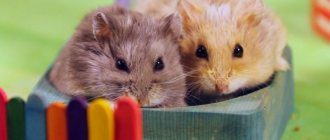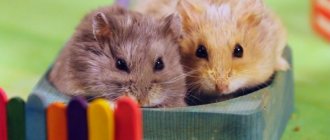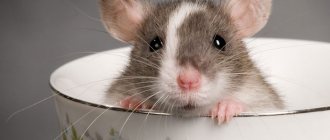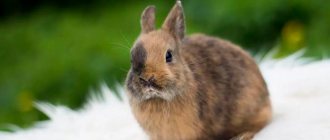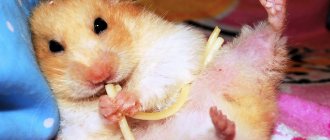- home
- Kinds
01.11.2018 Pets add variety to life and bring joy to children. The dwarf hamster does not take up much space in the house and is undemanding in care. It is enough to get to know the character of the rodent better, understand the principles of caring for it, and an entertaining miniature hamster will bring only pleasant emotions.
Varieties of dwarf hamsters
Proper handling and maintenance of dwarf hamsters requires knowledge of the characteristics and habits of each representative of this species.
The length of these animals does not exceed 50–70 mm, the average weight is 45 grams, and their life expectancy is about two years. Gentle pets need a caring attitude, but they are absolutely not problematic in terms of care and maintenance.
The most common representative is the Djungarian hamster, most often gray-brown in color, with a black stripe on the back. Taylor's dwarf hamsters are very similar to mice. The Campbell's hamster has a beautiful brown coat and a cheerful disposition. The Roborovsky hamster has a magnificent color, the fur on its back and head has a stunning sandy-golden hue, and its belly is white.
Each representative of dwarf hamsters has its own characteristics, but they are united by hyperactivity. This is a distinctive feature from its larger counterparts.
How to set up a home for a dwarf hamster
The dwarf hamster's space should be as large as possible so that he can exercise and play. A cage measuring approximately 30cm x 60cm and approximately 30cm high is the absolute recommended minimum.
Enclosure options: glass or plastic aquarium with a closed top for ventilation, wire cage with a plastic base. Cages provide better airflow to prevent overheating, although they don't protect against drafts like plastic or glass.
The distance between the wires should be small enough that your hamster cannot squeeze through the bars.
At the bottom of the cage there should be a layer of bedding up to 5 cm - shredded paper without chemical dyes or sawdust. Change them once a week, where you wash all surfaces in the enclosure with soap and water, and remove wet spots daily.
Warning: Avoid cedar-based bedding as it can be toxic to small animals.
Place an exercise wheel in the enclosure with a hard surface rather than bars to allow your hamster to run around.
Also put a large amount of wooden or mineral chewing sticks there. Chewing maintains the hamster's incisors, which are constantly growing. Additionally, add a small nest or sleeping house (available at most pet stores) so your hamster can rest and hide when he wants to feel safe.
Hamsters acclimatize well to average household temperatures. Just be careful of extreme temperature changes and keep the enclosure out of direct sunlight and drafts.
Djungarian hamster
Djungarians are funny rodents no more than 100 mm long and weighing up to 50 g. The animal has nice thick short fur. In nature, dzhungarikas have a gray-brown back with a bright black “ribbon” in the middle. The belly is always lighter, and the paws are white on the inside. Expressive eyes are black, convex and shiny, the muzzle is white.
Over the course of many years of selection of dwarfs with unusual deviations in color, the nurseries bred animals of interesting colors:
- tangerine almost red, but with the same stripe along the back;
- gray-blue, or sapphire;
- pearl without a characteristic stripe.
Dzungarik with a natural color is more resistant to disease. An animal with a mutation, an unusual color, very gentle and requires special care.
Red, or as they are also called, tangerine hamsters should not have joint offspring in order to avoid the birth of non-viable cubs.
Taylor's Hamster
Taylor's dwarf hamster does not grow more than 80 mm. Because of its nice elongated muzzle and elongated body, it resembles a funny mouse. Beady eyes and tiny ears complete the fabulous picture.
The fur is fluffy and soft, the color is brownish-brown, the belly is white, and there is an elegant dark stripe on top.
Hamster lovers immediately buy a pair, and the animals get along well and breed. After 20 days of pregnancy, the female gives birth to three or even five cubs. She can have 10 offspring in a year.
In addition to its body structure, Taylor's hamster has another similarity with mice: the female and male tenderly care for their offspring.
Where to buy a dwarf hamster
Dwarf hamsters are legal to own in most areas, although some homeowners may have special rules regarding small pets.
It is best to purchase a dwarf hamster from a responsible breeder or shelter, where you are likely to receive accurate information about the animal's origins and health history.
If you plan to purchase a hamster from a pet store, observe the animals closely to ensure they are kept in good sanitary conditions.
No matter where you get your hamster, try to look for an animal that is active and active. But remember that if you watch your pet during normal sleep hours, he may be a little sleepy.
In any case, he should have clear eyes and clean fur, and his litter should be well formed. Any discharge from the eyes or nose, as well as difficulty breathing, are signs of a potential health problem.
Campbell's hamster
The Campbell's hamster was once classified as a subspecies of the Dzungarik, but at the beginning of the 20th century it received its separate name from the British consul Charles Campbell, who brought amazing animals from the Russian-Chinese border.
Animals of both species are very similar to each other, but there are also significant differences:
- Campbells have slightly tousled fur, compared to the smooth, combed Djungarians;
- Campbells do not change color in winter, unlike dwarfs;
- the body has a “waist”, jungariki are egg-shaped.
Campbell's hamsters can be colored in the following colors: agouti, albino, opal, argenta, black, fawn, dove, blue, chocolate, lilac, blue spotted beige, platinum.
The main sign that this is a Campbell: unlike the friendly Djungarian, he does not like to sit on his hands and tries in every possible way to demonstrate his own independence. This is probably why Consul Charles Taylor liked the animal.
What do dwarf hamsters get sick with?
Dwarf hamsters are susceptible to a variety of health problems, and before purchasing one, you should find a veterinarian who will treat the animal.
Hair loss and skin damage can be the result of several different diseases. The most common causes are that the hamster is rubbing against something in the enclosure or is being attacked by a cage mate. Any skin abnormalities should be checked by a veterinarian as soon as possible.
Hamsters are also prone to indigestion, which is usually accompanied by some type of digestive tract infection. Wet tail is a bacterial infection that causes diarrhea, sometimes the result of stressful or unsanitary living conditions.
Hamsters with wet tails should be treated immediately by a veterinarian, as this condition can cause death within 48-72 hours.
Some dwarf hamsters, especially Campbell's and Chinese hamsters, are prone to diabetes. This can often be prevented by giving your pet low-sugar food and providing plenty of opportunities for exercise.
Yellow teeth are normal for a hamster, but sometimes his teeth can become overgrown, especially if he doesn't have enough chewing material to wear them down.
Overgrown teeth can affect your hamster's ability to eat, so they will likely need to be trimmed by your veterinarian. He will also advise what to do to maintain teeth of normal length.
Roborovsky's hamster
Roborovsky's hamsters are named after the Russian scientist who discovered and first described them. The homeland of the animal is China and Mongolia. But they are also found in Russia, for example, in the foothills of the Tien Shan.
Gradually, this animal won the hearts of lovers of miniature hamsters.
It is distinguished by its characteristic “bleached” eyebrows and fur-lined paw soles. Their eyes are always black. The color is most often a chic platinum color. There are variegated, snow-white, agouti, and cinnamon colors. In the wild, Roborov hamsters turn white in winter.
Breeders are attracted by the animal's high immunity to diseases. This is a distinctive feature of the Roborovsky hamster from its brothers.
Breeds of hamsters, their differences and which types are best for the home
What types of hamsters are there?
How to distinguish them from each other? What types of hamsters are suitable for keeping at home? You will find answers to these questions in the article. Let’s make a reservation right away that we will only talk about varieties of hamsters that can be tamed and domesticated. Let's take a quick look at wild rodents.
If you don’t understand breeds, this will grow up.
Care and choice of housing
The animals are extremely active, they need a large cage. You need to pay attention to the distance between the rods, which should not be more than 0.7 cm, otherwise the animal will run away.
Additionally, a running wheel, a small house for sleeping, labyrinths, and a sand bath are purchased.
Large sawdust or shavings are needed as filler, without dust, otherwise it will clog the animal’s airways. Do not use newspapers, as printing ink is poisonous to the hamster.
Hamsters are very clean. There is no need to bathe them, they will take care of themselves. But you need to clean the toilet as often as possible, otherwise an unpleasant odor will appear, and this is stressful for the pet.
It is very useful to let your hamster walk in a special walking ball. 15–20 minutes a day is enough to make a restless animal feel happy.
Today you can see two-level cages for hamsters on sale. Rodents, curious and nimble by nature, will definitely climb to the second floor. And then - depending on your luck. If they fall, there will be a tragedy. This must be taken into account when choosing a home for a miniature, delicate animal.
Radde or Cis-Caucasian, Dagestan hamster
Radde is similar to Syrian hamsters, only larger. They grow from 17 to 28 cm in length. They are usually brown in color with light and dark spots.
As a rule, Radde is not kept as a pet. In the wild, this breed of large hamster is considered a pest.
He lives in burrows and rarely walks in daylight, since the radde is a nocturnal inhabitant. Radde can become a carrier of diseases that are dangerous to people and cattle. If you want to make a radde as a pet, then be patient and diligent in domesticating it.
Composition and nutritional standards
The dwarf hamster is an omnivore. But there is no need to abuse this quality to the detriment of the rodent and feed it everything that a person has on the table.
The basis of the menu for hamsters is seeds, cereals, greens, fruits and vegetables. Hamsters develop activity and appetite, so it is better at this time.
In the morning, it is enough to give him pieces of fruit, vegetables, corn, peas, and a dandelion leaf. In the evening, the diet can be supplemented with fish, chicken breast, cooked without salt and spices.
Your hamster should always have water. Remove spoiled food promptly, otherwise the animal will be poisoned. The animal should always have grains in its bowl, otherwise it will think that the cold weather is coming and it’s time to stock up for the winter.
You cannot offer your hamster citrus fruits, pomegranate, kiwi, cookies and candies, chocolate, watermelons, cabbage, milk, sausage, chips, hot crackers and other foods that will quickly damage the rodent’s gastrointestinal tract.
Possible diseases
Dwarf hamsters may have the following diseases:
- conjunctivitis, when the eyes fester, the eyelids stick together;
- diarrhea due to poor diet;
- damage to the cheek pouches from spicy food;
- bite wounds;
- worms;
- improperly growing teeth due to the fact that hamsters are not provided with crackers and twigs for grinding them down;
- cystitis from infection or drafts;
- scabies, which is usually caused by the scabies mite.
For any diseases, you should not treat your hamster with “folk remedies”, but immediately show it to a veterinarian.
When caring for dwarf hamsters, you need to follow this principle: the less stress he has, the longer he will live. You need to train yourself not to raise your voice in the presence of a hamster, not to make sudden movements. Ultimately, you will prolong the life of not only your pet, but also yourself.
Source
Features of reproduction
In order for the couple to be successful and fertile, hamsters are accustomed to each other from an early age. If you plan to breed hamsters, it is advisable to immediately take a pair. There is no need to experiment with different subspecies. Only cubs born from Dzungariks and Campbells are viable.
In captivity, rodents can bear offspring all year round. As soon as the female turns four months old, she is ready to bear offspring. An earlier pregnancy is undesirable; it can have a bad effect on the mother’s well-being. The female carries the cubs for 20 days. One litter can have up to 12 newborns.
The female needs to create favorable conditions. First of all, this is a diet rich in protein foods; in addition, buy a complex of vitamins. Before giving birth, you need to remove the male. Remove labyrinths and simulators, add more sawdust. The female will make a good nest for herself.
Bald, blind and deaf hamsters will acquire a “beautiful” appearance in just a week. After 15 days they will be feeding themselves. After 25–30 days, the cubs need to be “sorted” by gender and placed in cages.
You cannot pick up babies. The female may become angry, react aggressively to someone else's scent and show a tendency towards cannibalism. If the hamster falls out, it is picked up with a spoon, which is first dipped in the bedding.


